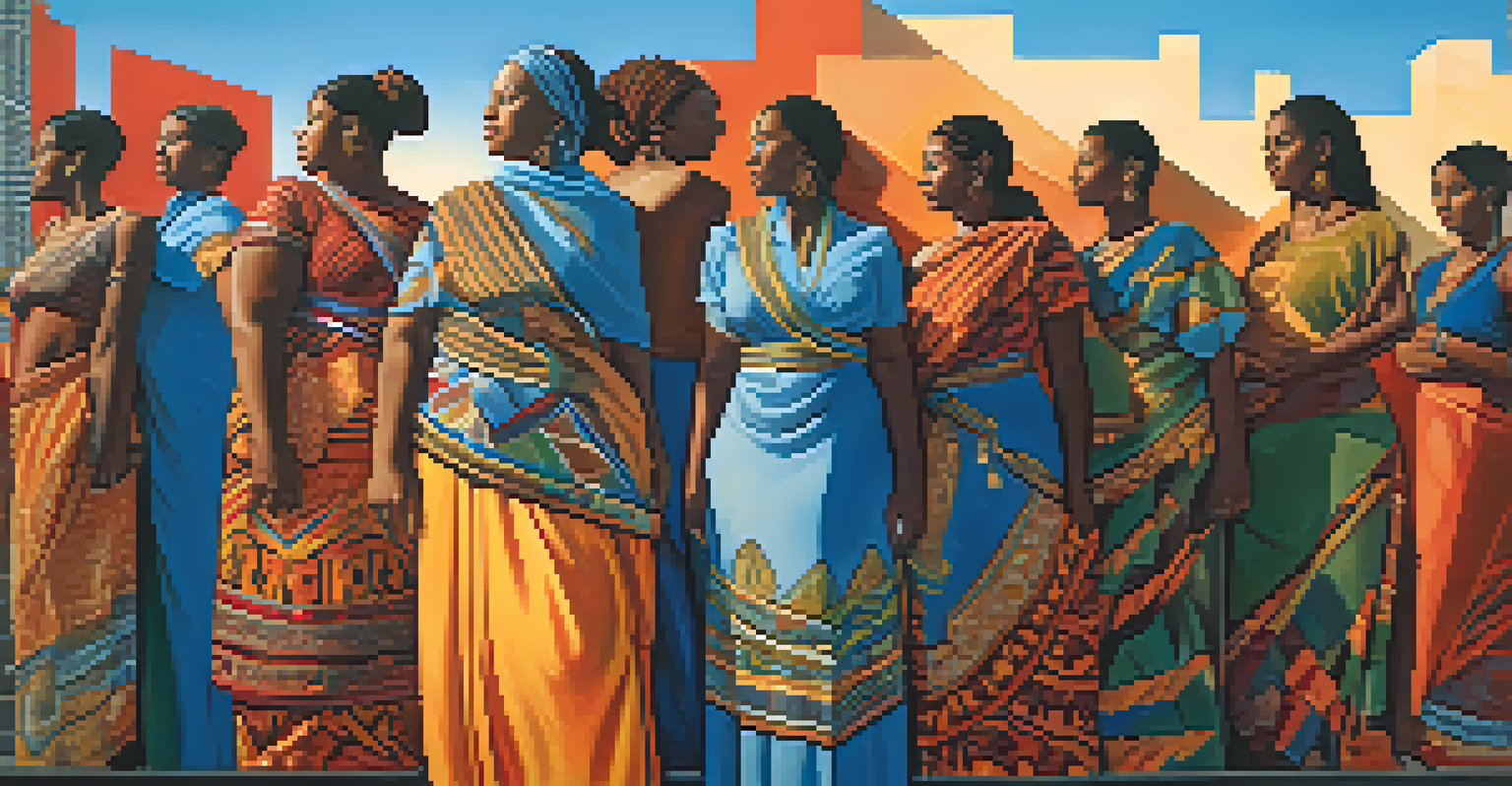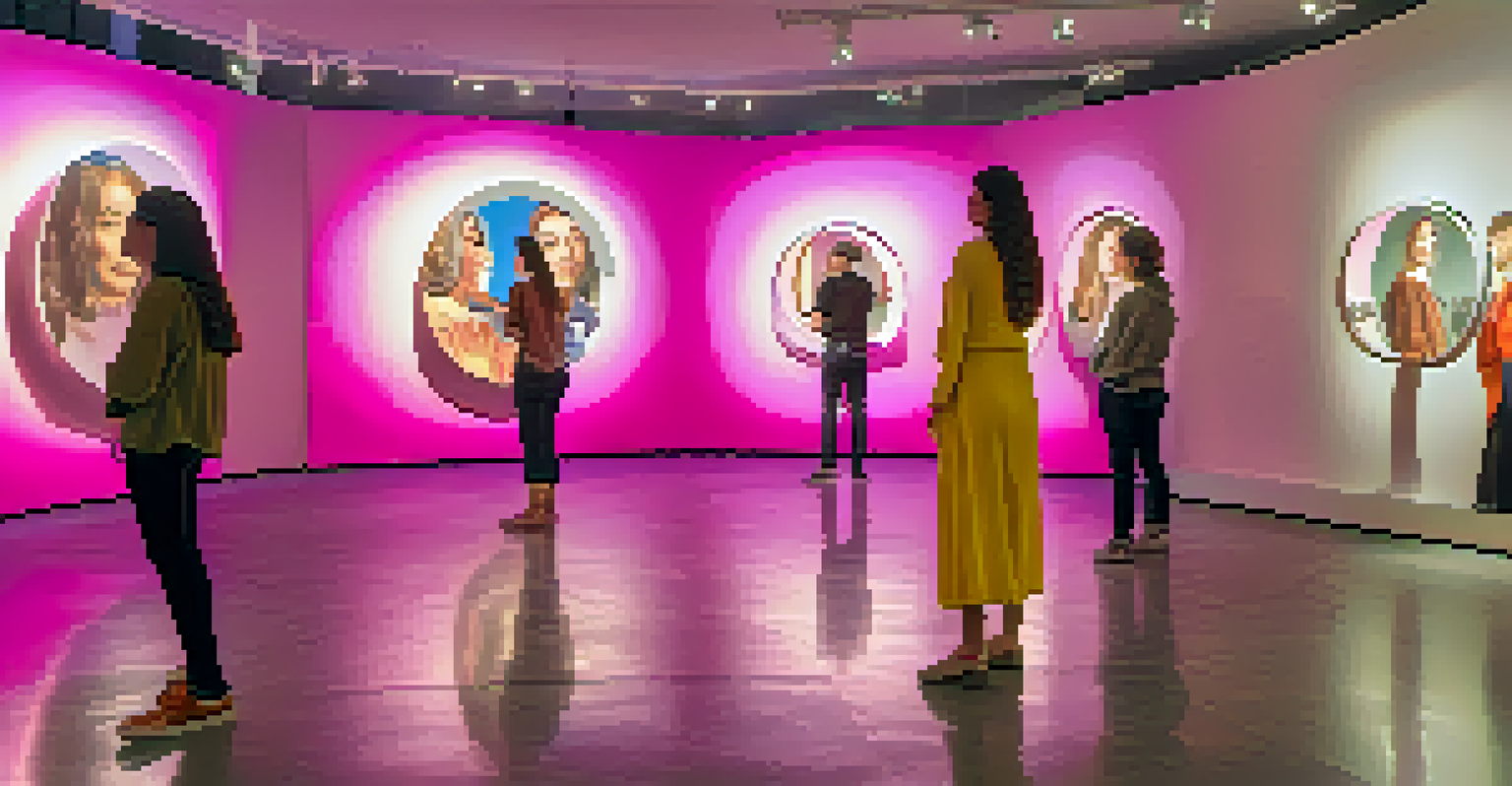Feminist Art and Its Influence on Gender Equality Movements

Understanding Feminist Art: A Brief Overview
Feminist art emerged in the late 1960s as a response to the male-dominated art world. It sought to challenge traditional representations of women and promote gender equality through creative expression. Artists like Judy Chicago and Cindy Sherman used their work to address issues of identity, sexuality, and societal norms, making feminism accessible to a broader audience.
The personal is political.
This movement not only questioned the role of women in art but also highlighted the importance of women's voices in various cultural contexts. By using art as a platform, feminist artists encouraged dialogue about gender roles and inequalities. Their work paved the way for future generations of artists to explore similar themes.
Feminist art is a powerful tool for raising awareness and sparking conversations about gender issues. It serves as a reminder that art can be both deeply personal and politically charged, allowing artists to influence societal change through their creativity.
Key Themes in Feminist Art
Feminist art encompasses a wide range of themes, including identity, body politics, and representation. Many artists explore how societal expectations shape women's lives and challenge the stereotypes that often surround them. By expressing their personal experiences, these artists create a broader understanding of gender issues.

For example, the use of the female body as a canvas or subject in artwork challenges traditional notions of beauty and femininity. Artists like Marina Abramović and Frida Kahlo have used their bodies to convey powerful messages about women's strength and vulnerability. This juxtaposition invites viewers to reconsider their perceptions of gender and the roles women play in society.
Feminist Art Challenges Norms
Feminist art emerged to question traditional representations of women and advocate for gender equality.
Additionally, feminist art often intersects with other movements, such as LGBTQ+ rights and racial equality. This intersectionality emphasizes that gender equality is not an isolated issue; it is deeply connected to other social justice movements, enriching the dialogue around feminism in contemporary art.
The Role of Feminist Art in Social Movements
Feminist art has played a crucial role in various social movements, from the Women's Liberation Movement to the #MeToo movement. Artists use their platforms to advocate for change and raise awareness about issues such as sexual harassment, reproductive rights, and workplace equality. This activism through art creates a sense of solidarity among individuals fighting for similar causes.
Art is not a mirror to hold up to society, but a hammer with which to shape it.
For instance, the iconic 'The Women's March' in 2017 showcased an array of protest art that captured the spirit of the movement. From handmade signs to powerful installations, these pieces communicated shared frustrations and hopes for a more equitable society. The visibility of feminist art during such events amplifies its message and inspires action.
Moreover, contemporary feminist artists often collaborate with activists to create impactful work that resonates with current social issues. This partnership not only elevates the voices of artists but also enriches the narratives within gender equality movements, illustrating how art can serve as a catalyst for change.
Influential Feminist Artists and Their Impact
Several artists have significantly influenced feminist art and its relationship with social movements. For example, Judy Chicago's 'The Dinner Party' is a groundbreaking installation that celebrates women's contributions to history and culture. This piece has become a symbol of feminist art and continues to inspire new generations of artists.
Another influential figure is Barbara Kruger, who incorporates bold text and imagery to comment on social issues, particularly regarding gender and consumerism. Her famous phrase, 'Your body is a battleground,' resonates with many, highlighting the ongoing struggle for women's rights and bodily autonomy. Through her work, Kruger challenges viewers to confront societal norms and reflect on their implications.
Art and Activism Unite
Feminist artists use their work to raise awareness about social issues, fostering solidarity and inspiring change.
These artists, among others, have not only shaped feminist art but have also become icons within gender equality movements. Their ability to merge art with activism demonstrates the profound impact that creative expression can have on societal change.
The Evolution of Feminist Art in the Digital Age
With the rise of digital technology, feminist art has evolved to reach a broader audience than ever before. Social media platforms allow artists to share their work instantly, fostering a sense of community and collaboration among feminists globally. This accessibility has led to the emergence of new forms of feminist art, including digital activism and online exhibitions.
Moreover, the internet provides a space for marginalized voices to be heard, amplifying diverse perspectives within the feminist discourse. Artists can challenge stereotypes and share their narratives through blogs, podcasts, and social media campaigns. This democratization of art has sparked a new wave of feminist activism that is both inclusive and intersectional.
However, the digital age also presents challenges, such as online harassment and the misappropriation of feminist messages. Artists must navigate these complexities while continuing to use technology as a tool for empowerment and social change. Ultimately, the evolution of feminist art in the digital landscape reflects the ongoing struggle for gender equality.
Feminist Art as a Catalyst for Change
Feminist art serves as a catalyst for change by inspiring action and fostering awareness about gender issues. Through visceral imagery and poignant narratives, artists evoke emotions and provoke thought, encouraging viewers to engage with the world around them. This emotional connection can lead to increased activism and a desire for societal transformation.
For instance, the work of artist Ai Weiwei challenges not only gender norms but also broader human rights issues. By addressing themes of oppression and resistance, his art compels audiences to reflect on their own roles in social justice. This interconnectedness of art and activism emphasizes the potential of creative expression to drive meaningful conversations.
Digital Age Expands Reach
The rise of digital technology has allowed feminist art to reach a broader audience and amplify diverse voices.
Additionally, feminist art often invites collaboration across disciplines, merging art with education, politics, and community organizing. By creating spaces for dialogue, artists can mobilize communities to advocate for change and work towards a more equitable future. The impact of feminist art is profound, as it continues to shape the trajectory of gender equality movements.
The Future of Feminist Art and Gender Equality
As we look to the future, the role of feminist art in advancing gender equality remains crucial. Artists will continue to push boundaries, challenge societal norms, and advocate for change through their work. The ongoing dialogue around feminism and art will likely evolve, reflecting the complexities of contemporary issues faced by women and marginalized communities.
Emerging artists are increasingly incorporating intersectional perspectives into their work, highlighting the interconnectedness of gender with race, class, and sexuality. This shift is essential for creating a more inclusive feminist movement that recognizes the diverse experiences of all individuals. The future of feminist art will be defined by this inclusivity and the commitment to social justice.

Moreover, as technology continues to advance, new mediums and platforms will emerge for feminist artists to explore. From virtual reality experiences to interactive installations, the possibilities for creative expression are endless. Ultimately, the future of feminist art will play a pivotal role in shaping a more equitable society, inspiring future generations to advocate for change.